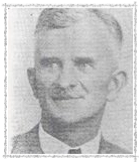 Barzilla Clark
Barzilla Clark
Treasurer's report
Building the church
the organ
Treasurer’s report - 1915 -
Monthly receipts $230.13
Expense
Pastor’s Salary $125.00
Benevolences $ 40.00
Janitor $ 17.00
District Superintendent $ 9.50
Coal $ 14.00
Chorister (Choir Director) $ 10.00
Organist $ 10.00
Music $ 11.00
The church was $63.61 in the hole!
The same report lists Frank Elewellyn Wemett as mister, W. L. Brewrink as chorister and Mrs. B. W. Clark as organist.
The congregation numbers 300.
![]()
1910’s… Building the Church
By 1913 the frame church had grown inadequate for the growing congregation. Rev. Frank Wemett returned from England with a dream of building a gothic style edifice on the site. During demolition and construction, the congregation met in a large tent set up across the street, with a sawdust floor and heated by a wood stove.
On April 19, 1916, Rev. Wemett appointed C. G. Peck, E. C. Read, J. I Hubbell, H. E. Ferguson, L. A. Hartert, H. W. Hops, W. S. Morgan and G. S. Samuel to the building committee who entered into a contract with John Visser of Twin Falls as an architect. The finance committee, comprised of W. S. Morgan, H. F. Kunter, L. A. Hartert, W. T. Wade, W. L. Shattuck, E. C. Read, Mrs. G. S. Samuel and E. C. Koener set about raising money. D. J. Sweeney was awarded the building contract. The cornerstone was laid in August 1916 with Bishop Cook of Montana officiating.
The stone building cost the congregation $47,000. The stone came from the foothills in the Ririe area, an area that is now under the water of the Ririe reservoir. They style is Tudor Gothic and the masonry is of veneer construction, the stone facing being backed with brick. The building was dedicated on October 17, 1917 with Brother Iliff in attendance.
The United States became engaged in the Great World War in 1917. This took 63 of our young men, (four of whom left gold stars as evidence of their great sacrifice). Much of our thought and money and but little could be done toward collecting the pledges for the liquidation of the church debt. After the Armistice was signed in 1918 the entire world was still in turmoil, trying to bind up the wounds inflicted by the war, until finally in 1920 the general depression ion the value of farm products came upon us with the result that our financial condition did not improve, however we had collected sufficient money with which to reduce the indebtedness on the church to $9000. In 1925 we saw the most bountiful crop and best prices for same in the history of the state. The members very willingly subscribed the remaining indebtedness and the writer, as President of Trustees takes great pleasure at this time in handing to you, Brother Turner, the canceled trust deed and the release of the same, the debt having been fully paid.
March 7, 1926 W. L. Shattuck
![]()
The Organ…
The present pipe organ was installed when the stone building was constructed in 1916 and 1917. It is a Hilgren Lane pipe organ and cost $3500.
Crow Creek Addition is named for W. H. B. And Sara Crow. Sara was organist for Rebecca Mitchell’s Sunday school class and was a charter member of Trinity.
The first organists included Mae Wengert, Mrs. Sam (Caroline) Dennis and Mrs. Barzilla (Ethel) Clark, who first played on a bellows organ. Mrs. Clark was the wife of a former mayor of Idaho Falls and governor of Idaho.
Joe L. Marker, whose mother Alma had the first music store in Eagle Rock often played for special occasions and provided a free concert to the community on his birthday each year.
“Music like religion, unconditionally brings in its train all the moral values to the heart it enters, even though that heart is not in the least worthy.” Jean Baptiste Montegu.
![]()